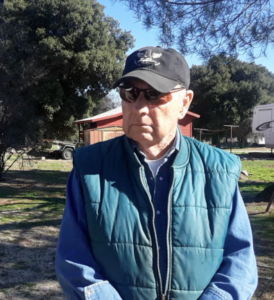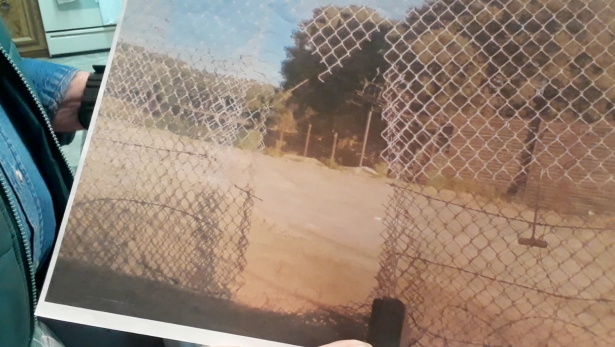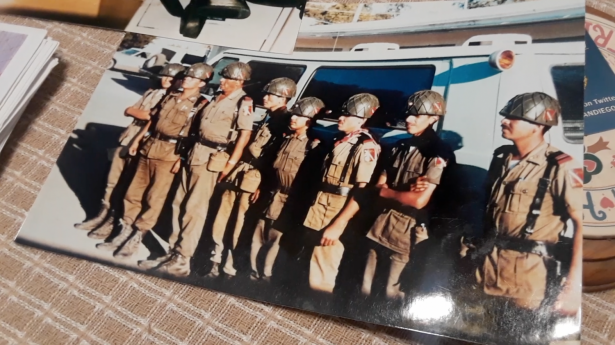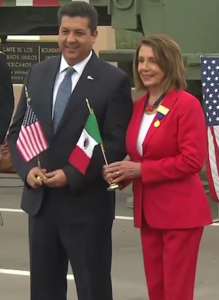“Why should I capitulate to a bunch of damn criminals? This is my country, not theirs.”

Robert (Bob) Maupin stands on his 250-acre ranch along the U.S.-Mexico border in Boulevard, east San Diego County. (Kimberly Hayek/NTD Television)
SAN DIEGO — Robert (Bob) Maupin, a 79-year-old retired mechanic and self-proclaimed vigilante, has spent decades and thousands of dollars protecting the U.S.-Mexico border from his own backyard. He built his own fence along the border just footsteps north of the U.S. government fence because he said the existing fence was inadequate.
Maupin lives in Boulevard in east San Diego County—one of the most rugged, remote, and desolate terrains in the San Diego border patrol sector. He inherited the 250-acre ranch from his father who purchased it in 1948. He moved here with his wife and high school sweetheart, Jeanette, and together, they raised their two children.
The southern edge of his ranch touches the border with Mexico. For more than 30 years, Maupin has been protecting his property with a 20-pound rifle and a 50-pound bulletproof vest from what he calls the “hordes of people invading [his] country.”
“I want [the U.S. government] to build a wall—all the way across—and that way I can have some peace and quiet.”
Maupin’s property currently has two fences: his own and just 60 feet south of it—the one belonging to the U.S. government. It took him five years and has cost more than $25,000 to build and repair his fence.
The government fence is made of steel landing mats, some of which are still left over in a pile on Maupin’s property today. It’s about 10 feet tall and was put up horizontally, allowing the groves on its sides to be used as steps to climb and hop over.
“Had the mat been installed vertically it would have been much harder to get over,” Maupin told The Epoch Times.
Government Fence Fails to Stop Foot Traffic
It was installed in the 1990s during Operation Gatekeeper, a border security initiative spearheaded by former President Bill Clinton. The San Diego border patrol sector was once the primary hub for illegal immigration and drug smuggling from Mexico, with almost half of total apprehensions of illegal immigrants across the United States happening in the region.
After the landing mat fence was put up, vehicles almost completely stopped driving straight through the border but it did not stop the pedestrians from crossing. The United States then constructed a secondary fence to run parallel to the westernmost part of the primary fence—which excluded Maupin’s east county property.
“They were watching the gates but they weren’t watching the fences in between the gates, or the ports of entry,” he said.
The fortified border to the west of Maupin forced the flow of pedestrians east and right onto his ranch where it was easier to cross, which is what eventually led him to build his own fence a few years later.
“I built my fence because the government fence is easy to climb. It slowed them down to give the Border Patrol more time to apprehend them.” Maupin’s fence is more than a mile-and-a-half long and 10-feet-tall, the same height as the government’s fence—but his is topped with razor wire.
“They had to take the time to cut my chain link fence or dig under it. It was easier to go around my property,” Maupin said. “That was the idea behind my building it.”
In the 1980s and 90s, before both walls were constructed, Maupin’s backyard was a hotbed for drug smugglers, violent gangs including MS-13, armed coyotes, and illegal immigrants trying to sneak across his ranch to enter the United States. Over the years, Maupin said he’s encountered thousands of illegal trespassers on his property.
“It sure screwed up our peaceful life here.”

Bob Maupin holds a photo of a hole in his fence cut in the shape of an “M”, for MS13. (Courtesy of Robert (Bob) Maupin.
In San Diego’s east county border patrol sectors of El Cajon and Campo, which includes Boulevard station where Maupin lives, there were about 120 agents responsible for patrolling approximately 50 miles of border at the time—that’s about 2 agents per mile, according to a report by the Department of Justice.
With no physical barrier stopping the flow of people and vehicles from crossing the border and onto his property, Maupin said he was forced to secure the border himself.
He built up a good rapport with the border patrol and went through the Customs and Border Protection Citizens Academy.
He also installed cameras all around his property. He wouldn’t tell The Epoch Times how many because he said “they” (cartels and smugglers watching from the hills on the Mexican side) would know. He also decked out his house with radios to communicate with volunteers patrolling his ranch and invested in gear and firearms.
When he catches a trespasser, he calls the border patrol. At night, he and a group of volunteers wear camouflage military gear and night vision goggles.
“We would get around the group and we would turn on the flashlight really really bright and then turn it off,” Maupin said. “Now they can’t see, all they can do is hear you and a couple of the guys that were out here with me spoke fluent spanish, so they would tell them to sit down.”
Maupin would then get ahold of his wife, she would call border patrol, and they would send vans out to pick them up. They used to catch anywhere between 20 to over 100 a night.
Armed Mexican Police, Army on Property
Maupin has a stack of photos that show large groups of people crossing the border onto his ranch and holes cut into his fence (some in the shape of an “M” for MS13). Some of the people in the photographs are Mexican officials working for drug smugglers. Maupin said they would cross the border onto his property as often as every week on “armed scouting missions,” looking for anything or anyone that could impede their route.
“It took me 5 years to build this fence,” he said. “They cut it open, I fix it.”
Maupin collects the photos to document the ordeals he’s had with illegal immigrants who entered the United States through his ranch. Most of them were taken in the 1980’s and 90’s.
The self-described vigilante said his cooperation with border patrol and the U.S. government is one of the reasons he’s had trouble with the criminal organizations along the border. After border patrol told him the cartel had placed a $20,000 bounty on him, he started wearing a bulletproof vest.
Then in August of 1985, Maupin said he and his family were held hostage for approximately 4 hours by a squad of Mexican army for reporting a meth lab on the Mexican side to the DEA.

crossing
“My wife and I were standing out in the patio and we smelled something that smelled like a doctor’s office,” the 79-year-old said. “So I thought about it for a minute and said, that’s gotta be ether.” Maupin immediately called a friend, an undercover narcotics agent, who told him ether is an ingredient used to make methamphetamine. “And he says they must be making it by the boatload down there if you think you can smell it all the way from Mexico to your house.”
His friend connected him with a DEA Agent based in Los Angeles, and together they mapped out the location of the meth lab on a Thomas Brothers Guide. Then, he told Maupin he would pass the information on to their Mexican counterparts, who were supposed to go close it down.
However, Maupin said they didn’t do that.

Speaker of the House Nancy Pelosi participates in a US-Mexico hug ceremony on the border near Laredo, Texas ‘HER’ idea of being “On the Border”
Instead, about a week later, a squad of Mexican army surrounded him and his teenage daughter while they were out on their ranch. They were disarmed and marched a quarter mile back to the house. Maupin led them through a cattle trail to allow his 17-year-old Denise to sneak back into the house to call border patrol. When the army realized they were on their way, they took off north but Customs and Border Protection (CBP) caught them.
“The reason they were here was to tell me to keep my nose out of their business,” Maupin said. That’s what the border patrol agents, who interviewed the eight soldiers before returning them to Mexico, told him.
After that incident, he hoisted an American flag on his front lawn.
Until the U.S. government builds a wall across the entire southern border, and despite the hard work and high cost of securing the border mostly on his own, Maupin said he doesn’t plan on stopping. But he would like to someday.
“Why should I capitulate to a bunch of damn criminals? This is my country, not theirs.”
Written by Kimberly Hayek for NTD News ~ February 21, 2019

 FAIR USE NOTICE:
FAIR USE NOTICE: